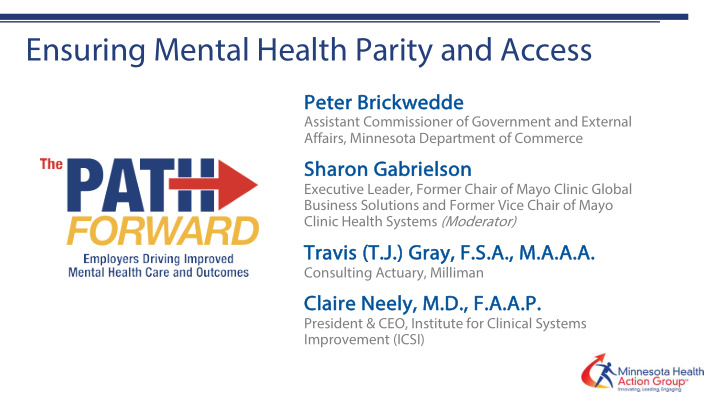



Ensuring Mental Health Parity and Access Peter Bri Peter rickwed edde Assistant Commissioner of Government and External Affairs, Minnesota Department of Commerce Sh Sharon G Gabr brie ielson Executive Leader, Former Chair of Mayo Clinic Global Business Solutions and Former Vice Chair of Mayo Clinic Health Systems (Moderator) Tra Travis is (T.J T.J.) .) Gra ray, , F.S .S.A .A., ., M.A .A.A .A.A .A. Consulting Actuary, Milliman Clai Claire Neely ly, M.D., F.A.A.P. President & CEO, Institute for Clinical Systems Improvement (ICSI)
Ensuring Mental Health Parity and Access to Care Discussion Panel T.J. Gray, FSA, MAAA MINNESOTA HEALTH ACTION GROUP 2020 SUMMIT APRIL 2020
Milliman’s Focus in Behavioral Health Mental Health Parity Program Design and Financial Analysis Compliance Evaluation § Rate setting and negotiation § Integrated medical- § Quantitative Testing support behavioral healthcare § NQTLs § Financial projections § Alternative payment models § Access to care § Cost and utilization § Policy analysis and special § Payment rates benchmarking topics research § Compliance guidelines § Fee schedule evaluation 4
Recent Milliman Research – Behavioral Health 5
Recent Milliman Research - OUD 6
Parity primer Quantitative treatment limitations (QTLs) • Financial requirements (copays, coinsurance, deductibles) • Benefit limits (visits, dollars) • Black and white mathematical tests: the “predominant” level for “substantially all” medical/surgical care can be applied to behavioral care • Comparatively easier to evaluate, demonstrate compliance Nonquantitative treatment limitations (NQTLs) • Any other processes, standards, policies, etc. that limit behavioral care. • Examples: prior authorization, medical necessity criteria, step therapy, provider payment rates, utilization management criteria, etc. • Gray area: Limitations for behavioral care should be “comparable to and no more stringent than” those applied to medical/surgical care, both “as written” and “in operation” 7
Recent Milliman Research – Impact of MHPAEA 8
Encouraging trends – benefit richness Improvements in “benefit richness” for commercial PPO plans, 2008-2013 6.2% 6.1% 4.8% 3.9% 1.2% 1.2% 1.1% Inpatient facility Outpatient facility Professional Total Medical/Surgical Behavioral -2.5% Source: Melek S, Perlman D, Davenport S, et al. Impact of Mental Health Parity and Addiction Equity Act. Milliman, November 2017. 9
Encouraging trends – use of behavioral services Average annual utilization trends for commercial plans, 2008-2013 HMOs PPOs 19.5% 18.9% 10.7% 9.4% 6.4% 5.9% 4.4% 4.1% 3.1% 2.0% 1.0% Inpatient facility Outpatient facility Professional Inpatient facility Outpatient facility Professional -1.1% Medical/Surgical Behavioral Medical/Surgical Behavioral Source: Melek S, Perlman D, Davenport S, et al. Impact of Mental Health Parity and Addiction Equity Act. Milliman, November 2017. 10
Recent Milliman Research - NQTLs 11
Key findings from NQTL Analysis § Out-of-network utilization rates for behavioral healthcare providers were higher than for medical/surgical providers in all five years and has increased across settings. § Average in-network reimbursement rates for behavioral health office visits are lower than for medical/surgical office visits. § Disparities in out-of-network use for SUD compared to M/S care are stark and have increased over the five-year study period. § Disparities in out-of-network utilization for office visits are greater for children than for adults , even as disparities related to reimbursement levels are greater for adults than children . § Improved access to behavioral healthcare services could reduce overall healthcare spending, because spending for “physical health” is approximately 2-3 times higher for patients with any ongoing behavioral health diagnosis. Source: Melek S, Davenport S, Gray, TJ. Addiction and mental health vs. physical health: Widening disparities in network use and provider reimbursement. Milliman, 12 November 2019
Room to improve – network access Higher proportion of out-of-network care for behavioral vs. medical/surgical in commercial PPO plans, 2013-2017 Source: Melek S, Davenport S, Gray, TJ. Addiction and mental health vs. physical health: Widening disparities in network use and provider reimbursement. Milliman, 13 November 2019
Room to improve – provider payment rates Office visits - percentage higher in-network reimbursement for primary care providers and medical/surgical specialists compared to behavioral providers in commercial PPO plans, 2013-2017 Source: Melek S, Davenport S, Gray, TJ. Addiction and mental health vs. physical health: Widening disparities in network use and provider reimbursement. Milliman, 14 November 2019
Ensuring Mental Health Parity and Access Peter Bri Peter rickwed edde Assistant Commissioner of Government and External Affairs, Minnesota Department of Commerce Sh Sharon G Gabr brie ielson Executive Leader, Former Chair of Mayo Clinic Global Business Solutions and Former Vice Chair of Mayo Clinic Health Systems (Moderator) Tra Travis is (T.J T.J.) .) Gra ray, , F.S .S.A .A., ., M.A .A.A .A.A .A. Consulting Actuary, Milliman Clai Claire Neely ly, M.D., F.A.A.P. President & CEO, Institute for Clinical Systems Improvement (ICSI)
Recommend
More recommend